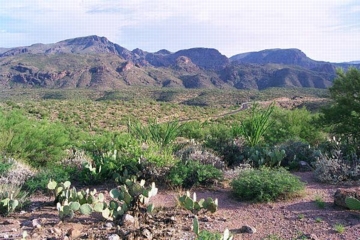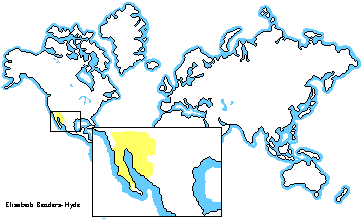


Climate More
information on the The Sonoran Desert
is one of North America's most interesting deserts, with
more plant and animal types than any other desert in the
world. It is the wettest and the warmest desert on the North
American continent. The Sonoran Desert is located in the
southwestern United States and northern Mexico. In the
United States it reaches from southeastern California to the
western two-thirds of southern Arizona. In Mexico it
includes much of the state of Sonora and the eastern shore
of Baja California. It covers an area of approximately
120,000 square miles. There are some mountainous areas where
frost occurs, but most of the desert is frost-free. The
Colorado, Yaqui, Salt, Verde and Gila Rivers pass through
this desert. The boundaries of
the Sonoran Desert are determined by the plants and animals
that live in the regions. The Arizona Upland region is
located in south-central Arizona and northern Sonora. It has
more mountain ranges than other areas of the Sonoran Desert
and is the highest and coldest region. The valleys are very
narrow. Saguaro
cacti are
found everywhere except on the valley floors. It is the only
region of the Sonoran Desert that experiences frequent hard
frosts. Succulent cacti, drought resistant and thorny shrubs
are common. On mountainous slopes towards the north, these
plants mix with chaparral type vegetation of dense thickets
and fire adapted plants The Lower Colorado
Valley is the largest, hottest and driest region of the
desert, and is known for its beautiful wildflowers displays.
Drought deciduous trees and shrubs are common here. Many are
very thorny to discourage browsers. Toward the south the
Sonoran Desert gradually merges into the Tropical Dry Thorn
Forest of southern Sonora and Sinaloa. The Sonoran Desert
on the Baja peninsula is also known as the Vizcaino desert.
Off-shore islands located in the Gulf of California are also
part of the Sonoran Desert. The summers aren't quite as hot
as the rest of the Sonoran Desert. A high mountain range
shields the desert from Pacific storms and accounts for the
small amount of rain that falls in the winter. Moisture and
fog from the Gulf of California can be considerable,
allowing epiphytes to grow on the desert plants. Many
different species of succulents like agaves and yuccas grow
here. The Sonoran Desert
is known for its beauty and for the amazing cacti and
succulents. Some 2,500 plant species grow in the harsh
conditions of the Sonoran Desert. More than 160 plant
species depend on other plants, like the nitrogen fixing
desert
ironwood,
mesquite,
and palo
verde trees,
to germinate and grow into mature plants. These trees
provide plants and animals with a habitat, food and shelter
necessary for their survival. Found on the Sonoran coastal
plain region, the desert ironwood is the oldest desert tree.
The ocotillo
has adapted to the severe climate by remaining leafless
during the coldest or driest months. They grow new leaves
with every rainfall, only to drop them a few weeks after the
rainy spell is over. During severe drought, they even drop
some of their branches. The most recognizable cactus in the
Sonoran Desert is the saguaro
cactus. The
chain
fruit cholla
and teddybear
chollas,
pipe organ, barrel
cactus, and
jojoba are some other cacti found here. Between late
February and mid April beautiful carpets of annuals like
poppies, lupines and owl clover cover the desert floor.
These flowers depend on rainfall and this display of flowers
occurs only about once in a decade. Locally a good bloom can
occur every three years or so. Winters need to come earlier
and be wetter than normal. Seeds of summer poppy and devil's
claw germinate soon after the first rain and begin flowering
only 3 weeks later. Chinchweed has adapted well to all
conditions, and ranges from New Mexico into the central
Mojave desert. Herbaceous
perennials and shrubs like penstemon, brittlebush,
and fairy
duster are
less sensitive to the timing of rainfall and are more
dependable bloomers than the annuals. These plants grow in
small patches and don't carpet the ground with color like
the annuals do however. Most herbaceous plants flower
opportunistically with enough rain, and sometimes more than
once. The desert zinnia will flower in both rainy seasons.
Ocotillo will grow and shed its leaves three weeks later
after every rain. The Sonoran Desert,
like many other deserts, was considered by people in the
past to be a wasteland. Now more and more people are
attracted to, and moving into the Sonoran Desert. They come
to enjoy the large open spaces the desert can give them, to
camp and experience the desert in their all-terrain
vehicles. Unfortunately, the lifestyles of people, and the
needs of wild life are often conflicting. Urbanization is
spreading further into the desert every year around Tucson,
Arizona. Roads bisect territories, and many animals become
road-kill as they attempt to cross. Many species won't cross
roads and become isolated in smaller and smaller pockets.
This reduces their ability to find mates and reproduce,
resulting in the extinction of that species in that
particular area of the desert. Large parts of the
Sonoran Desert are still intact due to careful planning and
conservation. The Coalition
for Sonoran Desert Protection
was responsible for getting The Ironwood Forest National
Monument designated on June 9, 2000. Located northwest of
Tucson this 129,000 acre area contains large stands of
ironwood trees and an amazing diversity of birds and
animals. Many areas are
already managed by the federal government. Organ Pipe Cactus
National Monument is run by the National Park Services,
Cabeza Prieta National Wildlife Refuge by the U.S. Fish and
Wildlife Service, and the Barry M. Goldwater Air Force Range
by the Department of Defense. All together these parks cover
more than three million acres west of Tucson, Arizona. The
National
Parks Conservation Association
proposes the establishment of a Sonoran Desert National Park
and Preserve. Legislation to authorize a study of management
options for the parks is pending in the US
Senate.
bibliography: "Protect the Sonoran
Desert", http://www.sonorandesert.org
"Sonoran",
http://www.npca.org/explore_the_parks/new_parks/sonoran.asp "Sonoran Desert",
http://www.azstarnet.com/~desertd/sonorn.html "Sonoran Desert
&endash; DesertUSA", http://www.desertusa.com/du_sonoran.html "Sonoran Desert
Naturalist Homepage", http://arizonensis.org/sonoran/index.html Dimmitt, Mark.
"Flowering Season in the Sonoran Desert", http://desertmuseum.org/desert/exh_flowering.html
Sonoran
Desert